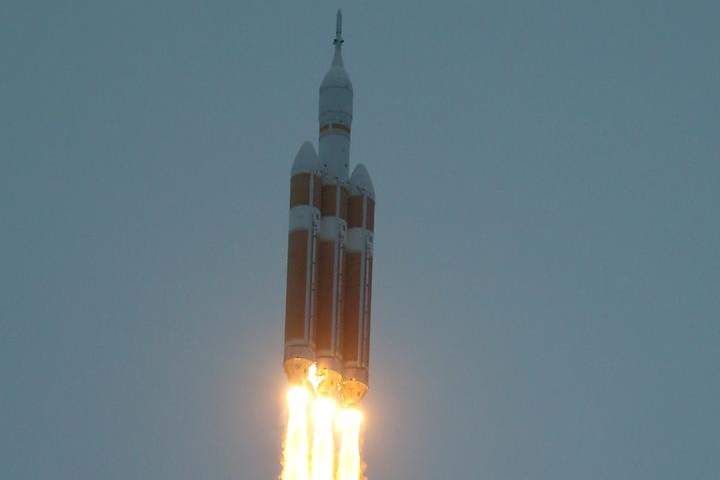TORONTO – This year marked a return to space.

And it wasn’t just about NASA. The interest in space has extended around the globe, to countries that, at the dawn of the American space program in the 1950s, would never have been considered to appear on the worldwide stage.
It also no longer solely resides in the hands of governments. Dreams of private companies working to take humans to space, or landing on comets or missions to Mars seemed to be taking shape in 2014. Here is a look at just some of the year’s highlights.
India goes to Mars
On Sept. 24, India celebrated a great scientific achievement: its Mars Orbiter Mission successfully reached orbit around the red planet. And it did it at 1/10th the cost of NASA’s Mars Atmospheric and Volatile Evolution mission which had reached Mars just days earlier.
It’s quite the achievement for a developing country of 1.2 billion people, most of whom are poor.
But India is no shrinking violet in the space industry: it has a very strong space program. On Dec. 18, it has also scheduled a test of a new rocket and capsule that will return to Earth, which some speculate will eventually carry three Indian astronauts into space.
We land on a comet
On Nov. 12, the European Space Agency‘s Philae probe — part of its Rosetta mission — marked a milestone in space travel when it landed on a comet.
Comet 67/P Churyumov-Gerasimenko was moving at 60,000 km/h, making for a nail-biting wait as Philae made its descent. Around the world, people anxiously awaited the first photos from the comet’s surface.
And Philae was successful — for the most part. It did land, but it encountered a few problems. First, not all of its harpoons — designed to keep it safely on the surface of the comet — fired. Then, making matters worse, it landed sideways, leaving part of its solar panels in shade, and unable to operate at full power. In the end, controllers put Philae into hibernation with the hope that, as the pair approach the sun, they will be able to reawaken the probe.
But Rosetta remains in orbit around the comet conducting its valuable scientific objectives.
The ESA proved that humans can do what was once only dreamed of in science fiction movies.

Private companies and their hurdles
“Rocket science…it’s just hard.”
–Paul Huter, a space design consultant
No truer words have been spoken about getting to space.
At the beginning of the rocket era, NASA suffered many setbacks as it tried to get Americans into space. Take a look through the agency’s early history and you’ll see just how many failed rocket launches it had, not to mention the loss of life. Though we may think we’ve come a long way, the technology to get humans into space is still the same. And it’s just as dangerous.
Orbital Sciences Corporation and Virgin Galactic learned this lesson in October.
On Oct. 29, Orbital Sciences, maker of the Antares rocket, launched from Wallops Flight Facility in Virginia. On board were cargo and experiments destined for the space station. However, six seconds into its flight, as it was barely off the launch pad, it became clear to operators that the rocket was not operating as it should. The command was given to destroy it before it flew out of control (this is a safety device built into every rocket).
READ MORE: Orbital Sciences likely to stop using engines used in rocket explosion
Onlookers watched as the rocket first exploded then crashed to the ground in a ball of flames, rocking the area.
Then, on Oct. 31, Richard Branson’s Virgin Galactic’s SpaceShipTwo — which will eventually offer tourists rides to space — suffered a catastrophic loss as it broke apart mid-flight, killing one pilot and injuring another.
Orion: A vision of Mars
We’ve been talking about going to Mars since we first set foot on the moon. However, somewhere along the way, between economic crises, political unrest and changing priorities, the red planet was left to science fiction movies. It’s been a very long time since humans left low-Earth orbit: this December marked 42 years since the last boot print was left on the moon.
With the end of the space shuttle era and the cancellation of the Constellation program that would take Americans to the moon, space travel seemed to be dead.
However, out of the ashes of Constellation arose Orion — the spacecraft that now was slated to take us to Mars.
And finally, this year we were able to see Orion soar.
WATCH: Orion marks the start of human’s return to space
On Dec. 5, after a launch scrub the day before, Orion lifted off into space for its first unmanned test flight. The flight was a test of several key systems that will be needed for a successful launch and return, including the effects of radiation on the computer systems and the heat shield.
The flight was successful, and now the world is once again buzzing about getting to Mars.
With the private involvement, new global players and a vision for the future, 2014 helped us see that space is still within reach.
–with files from The Associated Press


Comments